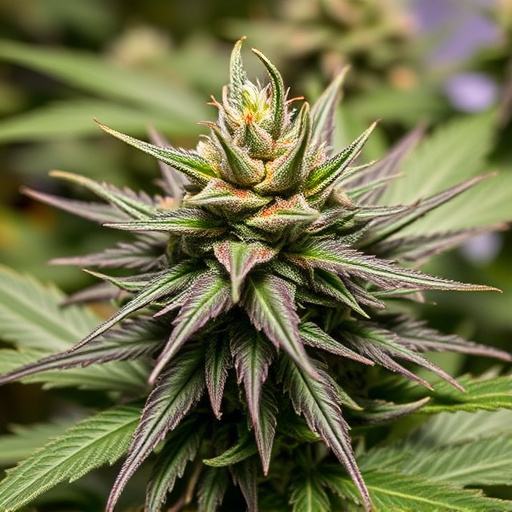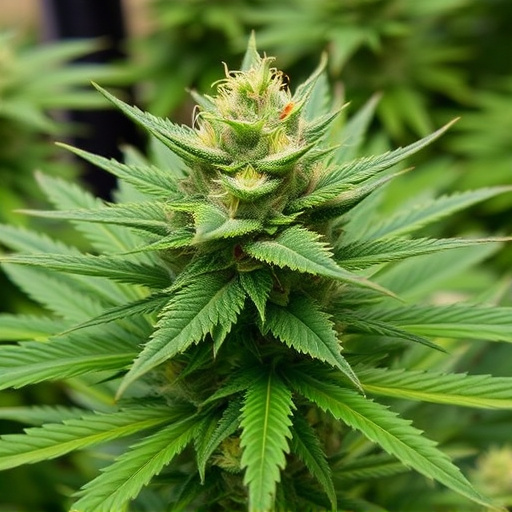Cannabis sativa strains have been used for centuries to manage pain due to their complex chemical compounds, particularly cannabinoids like THC and CBD, which interact with the body's endocannabinoid system. Modern strains often include higher CBD and lower THC levels, offering anti-inflammatory benefits and potentially more effective chronic pain relief compared to traditional medications. These specific strains are preferred for conditions like arthritis, fibromyalgia, or nerve damage, as they can block pain signals and reduce inflammation without psychoactive effects, making them an attractive natural remedy for pain management.
Cannabis flower has emerged as a potential natural remedy for pain management, offering relief for conditions ranging from acute injuries to chronic illnesses. This article delves into how cannabis interacts with our bodies through its key compound, THC, and how specific cannabis sativa strains can target pain signals effectively. By exploring the science behind the endocannabinoid system, we uncover why certain strains are particularly beneficial for managing chronic pain, providing insights into this increasingly popular alternative therapy.
- Understanding Cannabis and Its Effects on Pain Relief
- Exploring Cannabis Sativa Strains for Managing Chronic Pain
- The Science Behind Cannabis' Interaction with the Endocannabinoid System
Understanding Cannabis and Its Effects on Pain Relief

Cannabis, specifically cannabis sativa strains, has been used for centuries to alleviate various forms of pain. Its effectiveness in pain management is attributed to a complex interplay of chemical compounds, predominantly cannabinoids, found within the plant. These compounds interact with the body’s endocannabinoid system, which plays a crucial role in regulating pain perception and response.
One of the key cannabinoids responsible for cannabis’ analgesic (pain-relieving) properties is tetrahydrocannabinol (THC). THC binds to specific receptors in the brain and nervous system, modulating the transmission of pain signals. Many cannabis sativa strains have been bred to enhance THC levels while also containing other cannabinoids like cannabidiol (CBD), which has anti-inflammatory properties. This combination can provide more comprehensive pain relief compared to traditional medications, making cannabis a promising alternative or adjunctive treatment option for chronic pain sufferers.
Exploring Cannabis Sativa Strains for Managing Chronic Pain

Chronic pain is a complex condition that requires tailored treatment approaches, and one promising avenue is exploring the use of specific cannabis sativa strains. These strains have been found to contain unique chemical profiles, particularly high levels of cannabinoids like CBD (Cannabidiol) and lower concentrations of THC (Tetrahydrocannabinol). The endocannabinoid system in our bodies plays a significant role in regulating pain perception, making certain cannabis sativa strains an appealing option for managing chronic pain.
Research suggests that specific strains with higher CBD content can interact with this system to block pain signals, reduce inflammation, and promote overall well-being without inducing psychoactive effects. Unlike strains with high THC levels, which may lead to unwanted side effects, CBD-rich cannabis sativa strains offer a more balanced approach to managing pain, making them a popular choice for those seeking alternative treatments for chronic conditions such as arthritis, fibromyalgia, or nerve damage.
The Science Behind Cannabis' Interaction with the Endocannabinoid System

The human body has an endogenous cannabinoid system (ECS), which plays a significant role in regulating various physiological processes, including pain perception and inflammation. This intricate system is made up of endocannabinoids, receptors, and enzymes that work together to maintain homeostasis, or balance, within the body. Cannabis sativa strains contain chemical compounds known as cannabinoids, the most well-studied being THC (tetrahydrocannabinol) and CBD (cannabidiol). When consumed, these cannabinoids interact with the ECS by binding to specific receptors, such as CB1 and CB2.
THC is known for its psychoactive effects, but it also has a significant impact on pain management. It binds to CB1 receptors in the brain and spinal cord, modulating pain signals and reducing inflammation. On the other hand, CBD does not bind directly to CB1 or CB2 receptors but instead interacts with the ECS indirectly. Research suggests that CBD may help alleviate pain by inhibiting the reuptake of endocannabinoids, allowing them to stay active longer in the body. This interaction can provide potential therapeutic benefits for chronic pain conditions, making cannabis sativa strains a compelling option for natural pain management.
Cannabis, particularly its various cannabis sativa strains, offers a promising avenue for managing chronic pain through its interaction with the endocannabinoid system. The scientific understanding of these mechanisms is evolving, but existing research highlights the potential benefits of cannabis as a complementary treatment option. By exploring specific strains and their unique chemical profiles, individuals can find relief tailored to their needs. Further studies are necessary to unlock the full potential of cannabis in pain management while ensuring safe and effective use.














